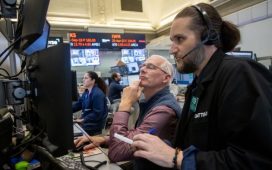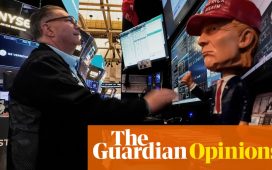Stay informed with free updates
Simply sign up to the US equities myFT Digest — delivered directly to your inbox.
US stocks closed the first half of 2024 14 per cent above where they started the year on Friday, even as investors voiced growing concern over the narrowness of a rally in which just five stocks have driven most of the gains.
The rise in the benchmark S&P 500 index was slightly below that seen in the bumper first half of 2023 but still ranks as one of the strongest performances for the opening six months of a year since the late-1990s dotcom bubble.
However, almost 60 per cent of the gain for the year to date was driven by just five “megacap” companies — Nvidia, Microsoft, Amazon, Meta and Apple — which have all been boosted by an investor frenzy over the potential of generative artificial intelligence. Nvidia alone accounted for 31 per cent of the market’s first-half advance.
The rally became even narrower in recent months, with Nvidia, Apple and Microsoft between them driving more than 90 per cent of the growth in the second quarter.
That has masked weaker performance among many of the index’s other constituents. The equal-weighted version of the S&P 500 was only up about 4 per cent year to date, and down in the second quarter.
There are growing signs of “weakness that has been developing under the surface of the market”, said Kevin Gordon, senior investment strategist at Charles Schwab.
“It’s not unusual throughout history to see the largest members account for large gains in the indices, but when the rest of the market is struggling, that’s when red flags pop up,” he added.
Nevertheless, some investors are hopeful that underperforming sectors will eventually start to catch up, without technology stocks going into reverse, following a pattern seen briefly in the fourth quarter of last year.
“AI has sucked all the oxygen out of the room,” said Andrew Slimmon, a senior portfolio manager at Morgan Stanley Investment Management. “It has so much exposure it has kind of left behind other areas.
“I think there’s a lot of companies in areas like industrials and financials where business is very good, yet they’ve been forgotten about,” he added.
He also expressed optimism that the second-quarter earnings season, which starts in mid-July, would help draw attention to fundamentally solid companies.
“This is the most concentrated that the market has been in at least 20 years,” said Denise Chisholm, director of quantitative market strategy at Fidelity.
Chisholm said most investors — influenced by comparisons with the dotcom bubble — assumed that the current high level of concentration was inherently unstable. However, she argued there had been several earlier periods when “the market stayed very concentrated for a very long time.
“I’m not saying it has to be a good thing,” she added. “But it’s difficult to come away as an investor with a data-driven approach and say ‘it’s definitely bad and I’m sure and would bet my portfolio on it’.”









